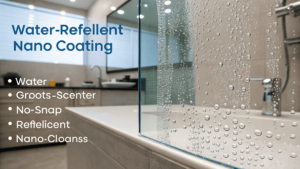Worried about the environmental impact and safety of solar panel materials? With growing concerns about toxic components in renewable energy, understanding cadmium telluride's role in solar technology is crucial.
Yes, some solar panels contain cadmium telluride (CdTe) as the main photovoltaic material. CdTe thin-film technology is the second most common type of solar cell, offering high efficiency and lower production costs compared to traditional silicon panels.
As someone deeply involved in supplying coating equipment for solar glass manufacturing, I've seen firsthand how CdTe technology has evolved. The key is understanding its efficiency, costs, and safety considerations. Let's explore the details that matter most for industry professionals.
How efficient is cadmium telluride solar panels?
Wondering if CdTe panels can match traditional silicon panels? Concerned about getting the best return on your solar investment? Let's look at the real performance numbers.
CdTe solar panels typically achieve 18-19% efficiency in commercial production, with laboratory cells reaching up to 22.1%. While slightly lower than high-end silicon panels, their superior performance in hot climates and lower production costs make them commercially competitive.
Having worked with numerous manufacturers implementing CdTe coating lines1, I've observed several key factors that influence their efficiency:
Temperature Performance
CdTe panels show distinct advantages in real-world conditions:
- Better performance in hot climates
- Lower temperature coefficient2 (-0.32%/°C vs. -0.45%/°C for silicon)
- Maintains efficiency better during peak temperature hours
- Ideal for desert installations
Spectral Response
CdTe technology offers unique benefits:
- Better absorption of visible light spectrum
- Less affected by partial shading
- Superior performance in diffuse light conditions
- Consistent energy production throughout the day
Production Efficiency Factors
Manufacturing quality significantly impacts efficiency:
- Coating uniformity crucial for performance
- Precise CdCl2 treatment essential
- Careful control of layer thickness
- Advanced production equipment required
The key to maximizing efficiency lies in precise manufacturing control, particularly in the coating process. Our coating lines achieve uniformity within ±5%, which is crucial for optimal performance.
How much do cadmium telluride solar panels cost?
Concerned about the initial investment in CdTe technology? Wondering if the cost savings justify switching from traditional silicon panels? Let's break down the real numbers.
CdTe solar panels typically cost $0.50-0.60 per watt to manufacture, compared to $0.70-0.80 for traditional silicon panels. Installation costs range from $0.85-1.00 per watt, making them one of the most cost-competitive solar technologies available.
From my experience working with manufacturers across the industry, several factors influence CdTe panel costs3:
Manufacturing Cost Factors
The production process offers several cost advantages:
- Simpler manufacturing process than silicon
- Lower material usage (2% of silicon panel thickness)
- Reduced energy requirements in production
- Higher automation potential
- Faster production cycle times
Installation Considerations
Installation costs benefit from:
- Lighter weight panels
- Simpler mounting systems
- Reduced labor requirements
- Better space utilization
- Lower BOS (Balance of System) costs
Long-term Value Proposition
Total cost of ownership4 advantages include:
- Better performance in hot climates
- Lower degradation rates
- Reduced maintenance needs
- Higher energy yield per watt
- Shorter energy payback time
Our coating equipment contributes to cost reduction through precise material application and high throughput, helping manufacturers optimize their production efficiency.
Is cadmium still used in solar panels?
Worried about environmental hazards? Concerned about regulatory compliance? Understanding cadmium's current role in solar technology is essential for making informed decisions.
Yes, cadmium is still widely used in CdTe solar panels, with First Solar being the largest manufacturer. However, it's only present in a stable compound form, and extensive studies show minimal environmental risk when properly manufactured and encapsulated.
As someone involved in supplying manufacturing equipment, I've seen how safety concerns have shaped production methods:
Safety Measures in Manufacturing
Modern production facilities implement extensive safeguards:
- Closed-loop material handling systems5
- Advanced air filtration
- Automated process controls
- Regular environmental monitoring
- Strict worker safety protocols
Environmental Considerations
The environmental impact is carefully managed:
- Stable compound form reduces risks
- Encapsulated between glass sheets
- Recycling programs in place
- Lower carbon footprint than silicon
- Reduced mining impact compared to alternatives
Regulatory Compliance
Manufacturers must meet strict standards:
- RoHS exemption for solar applications
- ISO 14001 environmental management6
- Workplace safety regulations
- End-of-life handling requirements
- Regular third-party audits7
Our coating equipment is designed to support these safety requirements while maintaining high production efficiency.
What are the advantages of cadmium telluride?
Evaluating different solar technologies? Wondering if CdTe offers genuine benefits over traditional options? Let's examine its key advantages for modern solar installations.
Cadmium telluride offers several significant advantages: lower production costs, better performance in hot climates, shorter energy payback time (less than one year), and smaller carbon footprint compared to silicon panels.
Through our work with manufacturers implementing CdTe technology, we've observed numerous benefits:
Performance Advantages
CdTe technology shows superior characteristics:
- Better temperature coefficient
- Improved low-light performance
- Less affected by partial shading
- Stable long-term output
- Higher energy yield in hot climates
Manufacturing Benefits
Production advantages include:
- Simpler manufacturing process
- Lower material requirements
- Reduced energy consumption
- Faster production times
- Higher automation potential
Environmental Impact
Environmental benefits are significant:
- Smallest carbon footprint among solar technologies
- Shortest energy payback time
- Established recycling programs
- Lower water usage in manufacturing
- Reduced mining impact
Our coating equipment maximizes these advantages through precise material application and efficient production processes, helping manufacturers deliver high-quality CdTe panels consistently.
Conclusion
CdTe solar technology offers a compelling combination of efficiency, cost-effectiveness, and environmental benefits. With proper manufacturing controls and safety measures, it represents a sustainable and competitive option in the solar industry.
-
Explore this link to understand how CdTe coating lines enhance solar panel efficiency and performance, especially in various climates. ↩
-
Learn about the significance of temperature coefficients in solar technology and how they impact energy production in different conditions. ↩
-
Understanding the factors influencing CdTe panel costs can help you make informed decisions about solar energy investments. ↩
-
Exploring the total cost of ownership for solar panels can reveal long-term savings and performance benefits. ↩
-
Explore this link to understand how closed-loop systems enhance safety and efficiency in manufacturing processes. ↩
-
Learn about ISO 14001 to see how it helps companies improve their environmental performance and compliance. ↩
-
Discover the significance of third-party audits in ensuring compliance and enhancing safety standards in manufacturing. ↩









